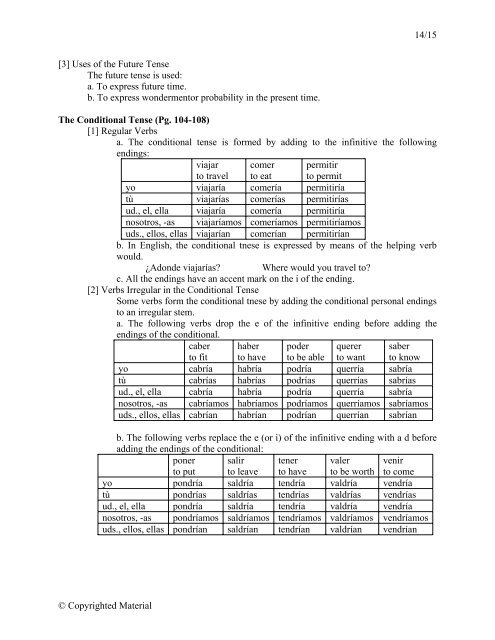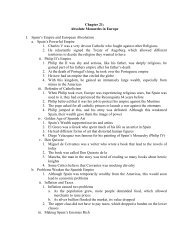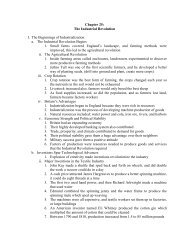1/15 © Copyrighted Material Spanish Final Study Sheet Ser vs. Estar ...
1/15 © Copyrighted Material Spanish Final Study Sheet Ser vs. Estar ...
1/15 © Copyrighted Material Spanish Final Study Sheet Ser vs. Estar ...
You also want an ePaper? Increase the reach of your titles
YUMPU automatically turns print PDFs into web optimized ePapers that Google loves.
14/<strong>15</strong><br />
[3] Uses of the Future Tense<br />
The future tense is used:<br />
a. To express future time.<br />
b. To express wondermentor probability in the present time.<br />
The Conditional Tense (Pg. 104-108)<br />
[1] Regular Verbs<br />
a. The conditional tense is formed by adding to the infinitive the following<br />
endings:<br />
viajar<br />
to travel<br />
comer<br />
to eat<br />
permitir<br />
to permit<br />
yo viajaría comería permitiría<br />
tù viajarías comerías permitirías<br />
ud., el, ella viajaría comería permitiría<br />
nosotros, -as viajaríamos comeríamos permitiríamos<br />
uds., ellos, ellas viajarían comerían permitirían<br />
b. In English, the conditional tnese is expressed by means of the helping verb<br />
would.<br />
¿Adonde viajarías Where would you travel to<br />
c. All the endings have an accent mark on the i of the ending.<br />
[2] Verbs Irregular in the Conditional Tense<br />
Some verbs form the conditional tnese by adding the conditional personal endings<br />
to an irregular stem.<br />
a. The following verbs drop the e of the infinitive ending before adding the<br />
endings of the conditional.<br />
caber<br />
to fit<br />
haber<br />
to have<br />
poder<br />
to be able<br />
querer<br />
to want<br />
saber<br />
to know<br />
yo cabría habría podría querría sabría<br />
tù cabrías habrías podrías querrías sabrías<br />
ud., el, ella cabría habría podría querría sabría<br />
nosotros, -as cabríamos habríamos podríamos querríamos sabríamos<br />
uds., ellos, ellas cabrían habrían podrían querrían sabrían<br />
b. The following verbs replace the e (or i) of the infinitive ending with a d before<br />
adding the endings of the conditional:<br />
poner<br />
to put<br />
salir<br />
to leave<br />
tener<br />
to have<br />
valer<br />
to be worth<br />
venir<br />
to come<br />
yo pondría saldría tendría valdría vendría<br />
tù pondrías saldrías tendrías valdrías vendrías<br />
ud., el, ella pondría saldría tendría valdría vendría<br />
nosotros, -as pondríamos saldríamos tendríamos valdríamos vendríamos<br />
uds., ellos, ellas pondrían saldrían tendrían valdrían vendrían<br />
© <strong>Copyrighted</strong> <strong>Material</strong>







